Thistle Harris Stead
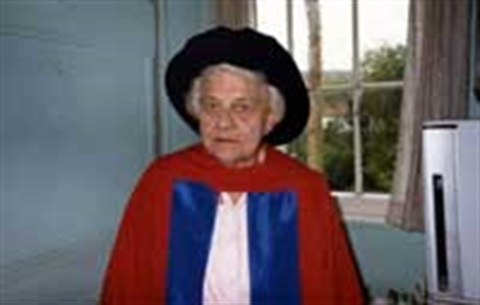
Pictured: Thistle Harris Stead Honorary Degree 1985
Private Collection
Early life, schooling and formative influences
Thistle Yolette Harris was born 29 July 1902, the second of three daughters born to Charles Thomas Harris and Illma Richardson Harris (née Rokes). Thistle’s father, who had joined the clerical staff of the Sydney Morning Herald as an office boy at age 17, remained with the organisation for his working life, eventually rising to the position of General Manager.
The Harris family lived at Mosman, and Thistle spent her primary school days at Mosman Superior Public School before beginning her secondary schooling at North Sydney Girls High School. From here she transferred to the independent girls’ school Redlands of which she was ultimately dux, to study for her Intermediate and then Leaving examinations.
At Redlands, Thistle’s lifelong interest in botany, and in particular in Australian flora, was awakened by her English teacher Constance Le Plastrier, a keen amateur botanist and active member of the Naturalists Society of New South Wales. Through this organisation, Le Plastrier was to introduce the sixteen year old Thistle to prominent naturalist David Stead (1877-1957) at one of the Society’s meetings. Stead would become not only Thistle’s intellectual guide and mentor but her partner in life. ‘We were one person’, she declared in the last years of her life in a personal letter to a friend (Webb, Joan p. 244).
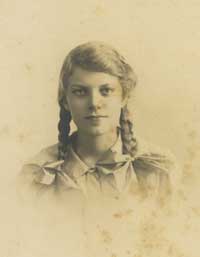
Thistle c1917
Private Collection
Higher education
Thistle studied science from 1921-1924, enrolling at the University of Sydney on a scholarship and graduating with a major in Botany. She followed her university studies with a Diploma in Education from Sydney Teachers College, where she would later herself lecture in biological science from 1938-1962. A series of teaching positions in NSW secondary schools preceded this from 1925-1938, when she published her first book, Wild Flowers of Australia – the first of twelve which she would author. Thistle later added to her academic qualifications attaining a Master of Education from the University of Melbourne and in 1970 a Diploma of Landscape Architecture from the University of NSW. An honorary Doctorate of Science was conferred upon her by the University of Wollongong in 1985 to mark, not only her work, but also ‘the cause for which she worked with such distinction, the sustaining of our natural heritage.’
Life at Watsons Bay with David and the Stead family
Thistle’s relationship with David Stead brought her to Watsons Bay as a resident in 1939. She joined him in what had been since 1918 the Stead family home, Boongarre at 14 Pacific Street, a two-storey weatherboard cottage built during the early 1890s. Here she would live until shortly before her death. Stead had re-named his home for an aboriginal leader who had been well known in colonial Sydney a century earlier, a choice entirely consistent with his social and humanitarian outlook which was long ahead of its time.
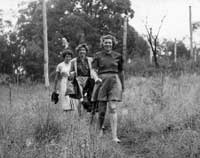
Thistle in the bush, 1930s
Private Collection
David Stead was a largely self-educated naturalist who had left school at 12 to take up an apprenticeship in lettering. Having studied zoology at Sydney Technical College while working as a compositor, he accumulated a knowledge and understanding of ichthyology which led to various positions for which a sound background in marine biology was required, working both in Australia and overseas. While he felt the want of university qualifications throughout his professional life, Stead was nevertheless both a published author and the editor of various journals and series in his field, as well as using radio broadcasts as a means of public education on the subject of wildlife preservation. He also presided over a number of respected scientific organisations and was a member of many others, and was a co-founder of the Wildlife Preservation Society of Australia.
David Stead’s influence on Thistle Harris cannot be overstated, but equally she was a crucial supporter of his work and campaigns, carrying on both after his death. More importantly, she was to take her own lead as an advocate for the environment, especially the native plant life of Australia which was her personal area of interest and expertise.
Twenty-five years Thistle’s senior and twice-married, David Stead was the father of seven children, several of whom remained at home at the time when Thistle moved into the Pacific Street house. From the accounts recorded in Joan Webb’s biography of Thistle, she enjoyed a happy association with her partner’s children and grandchildren. David Stead’s eldest child was the novelist Christina, the only child of his first marriage, who had been born in the same year as Thistle. Several of her novels are thinly veiled accounts of the Stead household and family life and include references to characters based on the young Thistle Harris. While Christina lived abroad for many years from 1928, correspondence between the two survives from this period and attests to a cordial, even warm relationship, although the two grew apart in later life for reasons that Thistle did not fully understand.
Stead and Harris eventually married on 15 June 1951, several months after the death of his second wife Ada, from whom he had long been estranged. David Stead died in 1957, but Thistle remained at Boongarre for a further thirty-three years, unable to leave behind the memories of her husband until forced to do so, several months before her death, due to fraility and ill health.
Later life
One endeavour which occupied a major part of Thistle Harris Stead’s life during its last three decades was Wirrimbirra, a property purchased at Bargo, south-west of Sydney, for the purposes of creating a wildlife sanctuary as a memorial to the life and work of David Stead. In her later years, Thistle retained her strong attachment to this piece of ground dedicated to her husband, driving to Bargo regularly, usually with a car and boot full of seedlings raised at Watsons Bay for transplanting at the sanctuary. Several of Thistle’s cars suffered rusted floors from her practice of keeping the little plants well-watered en route. These excursions ended when her drivers’ licence was revoked.
In 1965, Wirrimbirra was transferred from the Stead Foundation which had established the sanctuary, to the National Trust of Australia (NSW) in recognition of which perpetual commitment Thistle Harris Stead remembered the Trust generously in her will.
Thistle also continued to throw her weight behind environmental causes – one notable example being her active involvement in the campaign to save Lake Pedder, a unique glacial lake in south-western Tasmania which was threatened from the late 1960s by government plans for a hydro-electricity scheme. Thistle’s role involved regular travel to Tasmania to support those opposing the scheme and to address interested parties, while in the interim maintaining pressure through continuous lobbying from her Sydney base.
While the Pedder campaign itself failed to prevent the flooding of the lake in 1972, this act of wilderness destruction and the manner in which it was carried out had far reaching consequences. Public opinion was galvanised, government decisions and actions called into question and a spotlight shone for the first time on the role of the fledgling conservation movement which had opposed it. There is a general acceptance that the loss of Lake Pedder had direct bearing on the creation of the Tasmanian Wilderness World Heritage Area ten years later, and on much of the history of the green political movement from 1972 forwards. The gradual shifts in public perception were a vindication of a cause for which Thistle Harris Stead expended a life time working.
Listen to Sound Excerpt 1
Thistle Harris Stead died 5 July 1990 in a nursing home at Summer Hill, in Sydney’s inner west.
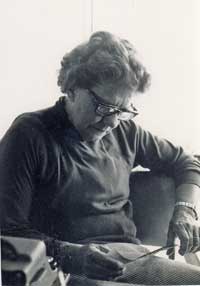
Thistle 1980's
Private Collection
Harris Stead’s role as an educator and environmental advocate
Behind Thistle Harris Stead’s determination and energies lay a personal, fully-developed philosophy of conservation grounded in social and humanitarian values and transcending any simple acceptance that the natural environment deserves preservation. Thistle linked the ideal of preservation to her belief that humanity had a deep-seated, ‘primitive’ need which could be fulfilled only through meaningful connection with the natural world, and she further linked environmentalism with other social causes, including world peace. As the world confronts climate change as a global issue, Thistle Harris’s arguments take on a new relevance.
Thistle Harris Stead’s greatest social contribution was her work as an educator and advocate for the Australian environment, and in particular for its diverse and unique flora. While her botanical knowledge was immense, it was in the passing on of her knowledge and her capacity to enthuse others that she has left a lasting mark.
Thistle had an unshakeable belief in the power of education, and strong views on what should be taught and how. Her biographer and former student Joan Webb recalls Thistle as one of the more useful and helpful of her lecturers at Sydney Teachers College, in that Harris set out to equip her students with a practical knowledge of how to conduct a lesson and manage a classroom. Thistle fought to have Nature Study included on the primary school curriculum and was a local pioneer in advocating sex education resources for children. Her nephew Alan Clark recalls that his aunt saw his education as one of the responsibilities entrenched in their nephew-aunt relationship.
Listen to Sound Excerpt 2
Thistle wrote in 1982 in the Who’s who of Australian Women,‘My time and energy are largely directed towards the education of people – particularly the young – in an understanding and appreciation of the natural environment’. She went on to express the belief that, only through an understanding of nature could ‘we hope to form a world of peace, free from exploitation of natural resources and of our fellow men, with less need for material things and a greater appreciation of other values, such as communication with one another.’
Much of this educational role was fulfilled through Thistle’s work as a teacher – both directly in a series of high school classrooms, and later at the Sydney Teacher’s College. But she educated also through her writing and her editing as well as through the organisations she worked for and supported. Her first publication, Wild flowers of Australia published by Angus & Robertson in 1938, was created around the botanical illustrations of Adam Foster. Harris’s text supplanted the originally commissioned writing of Edwin Cheel, State Botanist of New South Wales, whose work she judged too academic and heavy with technical detail for the ordinary reader. Thistle Harris created an accessible work which was nevertheless accurate and which became a standard text that stood for decades, reprinted many times and issued in seven further editions.
Listen to Sound Excerpt 3
Thistle’s impulse to educate lives on through Wirrimbirra, the garden and sanctuary intended to commemorate her husband’s contribution to the environmental cause. The program run at the sanctuary fulfils a largely educative role, just as the facility itself provides an opportunity for the urban public to experience and learn from a tract of undisturbed natural Australian bushland.
Thistle Harris Stead’s community involvement in Woollahra
Thistle’s early teaching career took her to new parts of Sydney and regional New South Wales, a period in her life during which she engaged with a succession of local communities and was clearly concerned with the natural environment wherever she lived. At Murwillumbah she set up a Girl Guides company and in Broken Hill conducted a naturalists’ society to interest the local residents in the desert plants on the town’s ‘doorstep’. The tree planting program she instigated in Kogarah while teaching at St George Girl’s High School was a cooperative effort between the school and the local council, an initiative which benefited her students with a practical demonstration of the principles she taught while endowing the community with an enduring legacy.
At Watsons Bay, where Thistle lived for the greater part of her life, she focused on the potential of important pockets of the natural bush as remnant examples amidst the increasingly urban, twentieth-century landscape. Through her work for the Vaucluse Progress Association’s Parks and Gardens sub-committee, Thistle acted as an advisor to Woollahra Council regarding plantings and designs of various parks in the area, including work at the Lighthouse Reserve in 1972. She also contributed substantially to the planning of Gap Park in the 1960s, setting the course for the principle which guides the management of this important piece of public parkland today: the preservation and regeneration of the native bushland.
Thistle Harris Stead also participated in local lobbying for various civic causes, such as assisting in the fight to retain the Post Office at Watsons Bay – a battle which consumed much of the energies of the small community during the 1980s – as well as leading the Committee for the Preservation of Gap Park twenty years earlier.
Thistle Harris Stead’s contribution to Gap Park
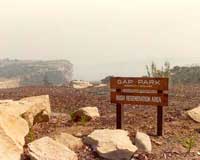
Gap Park, Watsons Bay February,1983
Copyright: Woollahra Library and Information Service
In 1961, Thistle Harris Stead led a successful campaign to determine the future of a 2 acre area which fell within the boundaries of Gap Park. The land, dedicated for some fifty years before this to the operations of the Watsons Bay tram line, reverted to local custody with the lapse of the tram service in July 1960. Alderman Belle Miller of Woollahra Council saw in this site the opportunity to create a ‘women only’ bowling facility for the municipality. A feasibility study endorsed Miller’s judgment, and in January 1961 Council agreed to the proposal, subject to the concurrence of the Minister for Lands.
It was at this point that Council’s intention became public, and a local lobby group, the Committee for the Preservation of Gap Park was formed in opposition to the scheme. Thistle Harris Stead acted as the spokesperson for this lobby group, and appears to have used her influence to gain support from the broader conservation movement, as there is evidence that the Wildlife Preservation Society of Australia was taking a watching interest as the issue unfolded.
For Thistle Harris Stead, the proposal to establish the Wentworth Women’s Bowling Club, as the facility was to be named, was an anathema on two grounds: the destruction of natural bushland and the alienation of public land for the use of a single-interest group. Belle Miller, herself a tireless campaigner in the local public interest was in this case arguing from a philosophical stance at direct odds to Thistle Harris Stead’s. With the benefit of hindsight, as bowling facilities languish throughout Sydney for the want of membership rejuvenation, it can be appreciated that the preservation of the native bushland at the Gap has been a land-use which has stood the test of time in a way that the provision of a bowling club would have not. In 1961, however, with prospective bowlers frustrated by long waiting-lists at an insufficient number of clubs, Miller’s arguments had validity, and should be viewed in the context of the period.
In March 1961 at a meeting of Woollahra Council, Thistle Harris Stead made representations on behalf of residents of Vaucluse ‘in opposition to the proposed alienation of about 2 acres of the 10 acres of Gap Park’ stating that the plan’s opponents ‘did not wish to see any further encroachments into public reserves for any minority use, particularly this section of natural bushland on which grew a wide variety of interesting and rare plants’ (WMC Minutes 27.3.1961, p.182). Ten months later the Minister for Lands refused permission for the bowling club, citing the need ‘to retain the whole of Gap Park for future development and unrestricted public use’ (WMC Minutes 11.12.1961, p.8).
With the bowling club proposal defeated, Woollahra Council resolved to investigate a long-term plan for the improvement of the park following the removal of the tram tracks. This resolution was to lead to Harris Stead’s continuing involvement with planning for Gap Park. In 1964, speaking through the Parks and Playgrounds Movement, she put forward the concept of planting a native garden ‘from the Grieve Memorial…to the car-park opposite Watsons Bay Hotel’. A list of suitable trees and shrubs was provided to council (letter from W. Hume to Woollahra Council 12.3.1964 and letter to Dr A. Halloran, 2.10.1964 in VPA Archives Parks and Gardens Committee). In a letter to the editor of the Wentworth Courier in October 1964, Thistle went into some detail about her plans, adding that the whole area could be ‘designed by a landscape architect and planted in sections, if necessary over a number of years’. She noted that ‘Australians are just beginning to appreciate the potentialities of many of their native plants’.
Woollahra Council did carry out improvements in Gap Park in 1965-6, and in 1967 Thistle Harris Stead wrote congratulating Council ‘on its choice of shrubs recently planted in Gap Park’ (WMC Minutes 28.8.1967, p.636). Her interest in Gap Park and her expertise in landscape design and native flora was acknowledged by Council when it invited her to join an inspection of Gap Park in April 1972 and further to prepare a schematic plan of improvements for the park (WMC Minutes 10.4.1972, p.1007). Harris Stead’s report and plan was considered by Council’s Trees and Gardens Committee in July 1972 and it summarised the proposal ‘in general terms as an attempt to improve the condition of the park by planting more trees and scrubs and supplying shelter sheds, seats and tables’ (WMC Minutes 25.9.1972, p.2675). In October 1972 Council adopted the recommendations of the committee that part of the scheme, which consisted of the ‘planting of various Australian shrubs and trees, the general cleaning up of the area and the construction of a shelter shed’ be implemented ‘in its entirety’ (25.9.1972, p.2675-6) with funds allocated for the following year (see also Wentworth Courier 18.10.1972, p.14).
It appears from the minutes of Council that Thistle Harris Stead continued to play an advisory role on the regeneration of Gap Park during the mid 1970s (WMC minutes 12.4.1976, p.66). Indeed, according to an article published in 1975 covering the work of Harris Stead, ‘her most pressing current project is the Gap Park at Watsons Bay’. (Community, pp.14-15.) Her nephew Alan Clark recalls that Thistle was often impatient with the pace at which her plans were being implemented by council’s works staff, and at times resorted to carrying out planting and other jobs herself.
The importance of Gap Park has since been recognised with its inclusion in the Watsons Bay Heritage Conservation Area, gazetted as part of the Woollahra Local Environmental Plan (1995) and its significance is outlined in the Watsons Bay Heritage Development Control Plan.
In 1982, landscape architect Noel Ruting wrote the following of Gap Park in a report to the Heritage Council of New South Wales, ‘This small area of enclosed heathland is unique in the municipality. Considering its location…its value is not only to the local community but to the region and beyond. The quality of the bushland is an important element in the overall experience of the place and it may well be the only piece of bush seen closely by many overseas tourists.’
Involvement with organisations
The many organisations which Thistle Harris supported or actively steered were the other major vehicle for her tireless campaign to raise community consciousness. Perhaps the most notable of these organisations was the Wildlife Preservation Society of Australia which her husband helped to found, one of the oldest organisations of its type in the world, which celebrates its centenary in 2009. Thistle served as both honorary secretary and president at various times, but in later years, at odds with other of the membership about the direction of the Society and the usage of its funds, she withdrew her support.
However, Thistle Harris Stead was involved with numerous organisations concerned with native flora and the preservation of the environment, such as the Australian Forest League, Junior Tree Wardens, and the Parks and Playgrounds Movement. She was a councillor of the Australian Conservation Foundation and the Nature Conservation Council NSW and founded the Wirrimbirra Nature Sanctuary under the auspices of the David G Stead Memorial Wildlife Foundation of Australia and later the National Trust of Australia (NSW). At various times she was editor of New Horizons in Education, Australian Wildlife and Wildlife Research News.
At a local level, Thistle was a member of the Vaucluse Progress Association (VPA), which benefited specifically from her immense knowledge of Australian horticulture and her landscaping expertise through her service on the Association’s Parks and garden sub-committee in 1972/3.
She was also involved with numerous political organisations, including groups working for world peace (member NSW Peace Council), the Communist Party of Australia, various committees of the NSW Teachers Federation and a number of women’s organisations. She had a special interest in the establishment of women in executive positions.
Character
Harris Stead’s biographer, Joan Webb has commented that her subject’s life was controlled by two passions – her passion for David Stead and her passion for the environment. Thistle was known for pursuing her interests and causes with a single-minded determination, fearless and unwavering, traits which sometimes made her difficult and unaccommodating of the views of others.
Listen to Sound Excerpt 4
She left in her wake the memory of some famous stoushes with colleagues and other conservationists, such as the split she caused in the local movement when she contemplated winding up the Wildlife Preservation Society to channel the organisation’s funds into Wirrimbirra. This was one battle which Thistle was destined to lose.
Her intense focus on her interests produced a true eccentric, indifferent to social niceties and the opinion of others. Joan Webb recalled in interview for the Women in Woollahra project the amazement she shared with her fellow 1950s Teachers College students when Thistle changed her clothes by the side of the roadway to prepare for a field trip. Stripping to her underwear in broad daylight, and in full view of passing motorists, Thistle was oblivious to her student’s discomfiture and completely without embarrassment herself.
Nephew Alan Clark recalls her as an erratic driver who was all too readily distracted by examples of flora by the roadside, while colleagues told of her taking her car off-road and driving across open paddocks to examine a tree. Camping holidays with her nephew were intended as educational experiences, collecting specimens and preserving them in a wooden press. She was unfazed by motoring tribulations, patching tyres en route and on one occasion limping into the nearest town with one tyre stuffed with eucalyptus leaves.
Legacy and achievements
Thistle Harris Stead’s legacy as a vocal practitioner and exponent of nature conservation is a far-reaching one, her influence widely dispersed through her teaching and writings as much as through her direct participation in the movement through organisations and lobby groups.
Australians are indebted to Thistle for awakening professional and domestic gardeners alike to the horticultural possibilities of the native flora, promoting its use in gardening schemes through her later books.
Listen to Sound Excerpt 5
In Gap Park at Watsons Bay we find the practical legacy of her political voice as an advocate for native bushland combined with her expertise as a landscaper and her authoritative knowledge of Australian plant life. Residents of Woollahra share this benefit with the many overseas tourists who visit the South Head annually and are given a glimpse not only of the outstanding views and dramatic sandstone landscape but of the native Australian bush. As an example of her landscaping work and conservation philosophy it receives far greater exposure than the Wirrimbirra sanctuary that is often considered her memorial as much as her husband’s.
Harris Stead’s contribution was recognised in a number of awards. In 1980, Thistle Harris Stead was appointed a Member of the Order of Australia for service to wildlife conservation. She had previously been awarded the National Trust Natural History Medallion (Vic.) in 1963 and the National Trust of Australia Medallion in 1964.
In an obituary in the Australian Garden Journal Dec 1990-Jan 1991 Thistle was remembered as ‘a kindly, generous and immensely knowledgeable person’ who ‘will long be remembered for her contribution to the study of the Australian flora and to wildlife conservation generally’.
Publications
Thistle Harris Stead wrote many books on Australian plants including her first in 1938, Wildflowers of Australia. In all she wrote 12 books :
- Wildflowers of Australia, 1938
- Nature problems, 1945
- Handbook of nature study for teachers, 1945
- Australian plants for the garden,1953
- The teaching of nature study, 1954
- Eastern Australian Wildflowers, 1962
- Australian plant life 1967
- Plants without flowers, 1967
- Alpine plants of Australia, 1970
- Gardening with Australian Plants series: Shrubs, 1977,
- Small plants and climbers, 1979
- Trees, 1980
She contributed to journals and works of reference including: The Australian Naturalist, Australian Wild Life, Australian Encyclopaedia and Science Wonders of Australia and edited the journals of several organisations as noted above.
Sources
‘An Activist since 1918’ in Community Aug 1975, p.14.
Australian Encyclopedia, 1988
Heimans, Frank ‘Thistle Harris Stead : interview of Joan Webb and Alan Clark’, ‘Women in Woollahra’ Oral History Project, November 2008.
Local History Research Files ‘Wentworth Women’s Bowling Club’ and ‘Gap Park’.
Webb, Joan, Thistle Harris biography, 1988
Wentworth Courier 18.10.1972, p.14
Woollahra Council Minutes 1960-67
Who’s who in Australia, 1980
Who’s Who of Australia Women, 1982